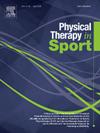Intrinsic foot muscles size and quality changes after impairment-based rehabilitation in patients with chronic ankle instability
IF 2.2
3区 医学
Q1 REHABILITATION
引用次数: 0
Abstract
Objective
To determine IFMs size and quality using US imaging following rehabilitation in patients with CAI.
Design
Prospective cohort study.
Settings
University Laboratory.
Participants
26 patients with CAI (age:21.9 ± 3.5 yrs; 18F, 8M) completed 8 clinician-supervised rehabilitation sessions over a 4-week period.
Main outcome measures
US imaging assessed IFM cross-sectional area (CSA) in seated and standing positions for both trained and untrained legs before and after the intervention. Muscle quality was evaluated using grey scale analysis for echogenicity.
Results
Significant (P < 0.01) increases in normalized CSA were observed for AbH and FDB in both seated and standing positions. Significant improvements (P < 0.05) were also seen in the untrained leg during standing. No significant changes were found in seated positions or in echogenicity for AbH (P = 0.26) and FDB (P = 0.052) for the trained leg.
Conclusion
IFM CSA increased post-rehabilitation, with some cross-over effects in the untrained leg. There was a certain cross-over effect observed. The muscle quality measures didn't change for the IFMs before and after rehabilitation. The IFMs strengthening should be included in CAI rehabilitation programs. There is a definite increase in size after rehabilitation. However, for quality changes there may be a need of longer rehabilitation programs.
慢性踝关节不稳患者损伤康复后内在足部肌肉大小和质量的变化
目的利用超声显像评价CAI患者康复后ifm的大小和质量。前瞻性队列研究。SettingsUniversity实验室。参与者26例CAI患者(年龄:21.9±3.5岁;18F, 8M)在4周的时间内完成了8次临床医生监督的康复治疗。主要结果测量:在干预前后,超声成像评估了训练腿和未训练腿在坐姿和站立位置的IFM横截面积(CSA)。肌肉质量用灰阶分析评价回声性。结果:P <;坐下和站立时,AbH和FDB归一化CSA均升高0.01)。重大改进(P <;在站立时,未训练的腿也出现0.05)。训练腿的AbH (P = 0.26)和FDB (P = 0.052)的坐姿和回声性均无显著变化。结论ifm CSA在康复后增加,在未训练腿有一定的交叉效应。观察到一定的交叉效应。康复前后肌肉质量指标无明显变化。应将ifm的强化纳入CAI康复方案。康复后,尺寸明显增加。然而,对于质量的改变,可能需要更长的康复计划。
本文章由计算机程序翻译,如有差异,请以英文原文为准。
求助全文
约1分钟内获得全文
求助全文
来源期刊

Physical Therapy in Sport
医学-康复医学
CiteScore
4.50
自引率
8.30%
发文量
125
审稿时长
39 days
期刊介绍:
Physical Therapy in Sport is an international peer-reviewed journal that provides a forum for the publication of research and clinical practice material relevant to the healthcare professions involved in sports and exercise medicine, and rehabilitation. The journal publishes material that is indispensable for day-to-day practice and continuing professional development. Physical Therapy in Sport covers topics dealing with the diagnosis, treatment, and prevention of injuries, as well as more general areas of sports and exercise medicine and related sports science.
The journal publishes original research, case studies, reviews, masterclasses, papers on clinical approaches, and book reviews, as well as occasional reports from conferences. Papers are double-blind peer-reviewed by our international advisory board and other international experts, and submissions from a broad range of disciplines are actively encouraged.
 求助内容:
求助内容: 应助结果提醒方式:
应助结果提醒方式:


